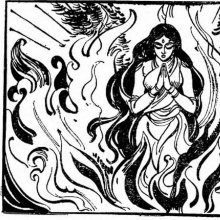Sandal-paste: 1 definition
Introduction:
Sandal-paste means something in Hinduism, Sanskrit. If you want to know the exact meaning, history, etymology or English translation of this term then check out the descriptions on this page. Add your comment or reference to a book if you want to contribute to this summary article.
Images (photo gallery)
In Hinduism
Pancaratra (worship of Nārāyaṇa)
Source: archive.org: Catalogue of Pancaratra Agama TextsSandal-paste (for the hands) is typically offered to the icon of the Lord as part of “liturgical worship”, as discussed in chapter 6 of the Sattvata-Samhita: one of the most ancient of Pancaratra Agamas consisting of roughly 3500 verses which stresses the theological standpoint of the oneness of God despite his various vyuhas (modes of existence), vibhavas (manifestations) and avataras (incarnations).—Description of the chapter [sūkṣamavyūha-devatā-bahiryāga-vidhi]: The details of how the liturgy step-by-step is prepared for and how it proceeds are given (7-131). [...] A special bathing cloth is advanced (29b), and then various items are given in order (verbally?) to the icon—[e.g., sandal-paste for the hands] [...]. During these baths incense will have been offered, after which incense-scented and -purified towels are offered to cleanse off the deity’s body-one for the head and one for the body. [...]

Pancaratra (पाञ्चरात्र, pāñcarātra) represents a tradition of Hinduism where Narayana is revered and worshipped. Closeley related to Vaishnavism, the Pancaratra literature includes various Agamas and tantras incorporating many Vaishnava philosophies.
See also (Relevant definitions)
Partial matches: Paste, Sandal.
Query error!
Full-text (+459): Gandha, Candana, Gandham, Akkebottu, Adhirushita, Udaya, Melkaisu, Mudra, Addabottu, Camdanacarce, Kappuragamdha, Cantanancattu, Arcanopakarana, Kirugamdha, Gutanama, Ushira, Vastrayugma, Urdhvapundra, Girugamdha, Amgaramgabhoga.
Relevant text
Search found 132 books and stories containing Sandal-paste, Sandal-pastes; (plurals include: pastes, pasteses). You can also click to the full overview containing English textual excerpts. Below are direct links for the most relevant articles:
Garuda Purana (by Manmatha Nath Dutt)
Chapter C - Worship of Vinayakas Durga < [Agastya Samhita]
Chapter CXIX - Agastyatritiya Vratam < [Brihaspati (Nitisara) Samhita]
Chapter CXXIII - Kartika Vratas < [Brihaspati (Nitisara) Samhita]
Temples of Purushottama Kshetra Puri (by Ratnakar Mohapatra)
5. Daily Rituals of Lord Jagannatha Temple < [Chapter 3 - Lord Jagannatha Temple]
Sushruta Samhita, Volume 6: Uttara-tantra (by Kaviraj Kunja Lal Bhishagratna)
Chapter XLVII - Symptoms and Treatment of Alcoholism (Panatyaya) < [Canto III - Kaya-chikitsa-tantra (internal medicine)]
Chapter LXIV - Rules of Health < [Canto V - Tantra-bhusana-adhyaya (embellishing chapters)]
Chapter XLIX - Symptoms and Treatment of Vomiting (Chardi) < [Canto III - Kaya-chikitsa-tantra (internal medicine)]
Brahma Sutras (Nimbarka commentary) (by Roma Bose)
Brahma-Sūtra 2.3.23 < [Adhikaraṇa 9 - Sūtras 19-31]
Brahma-Sūtra 2.3.24 < [Adhikaraṇa 9 - Sūtras 19-31]
Skanda Purana (by G. V. Tagare)
Chapter 6 - The Fruit of Offering Tulasī Twigs and Sandalpaste < [Section 5 - Mārgaśīrṣa-māhātmya]
Chapter 46 - Celebration of Yātrā by Dakṣa (on Akṣayatṛtīyā) < [Section 2 - Puruṣottama-kṣetra-māhātmya]
Chapter 4 - Worshipping the Conch < [Section 5 - Mārgaśīrṣa-māhātmya]
Tilakamanjari of Dhanapala (study) (by Shri N. M. Kansara)
4. Motifs (13): The holy sandal paste and the garland < [Chapter 8 - The Plot and the Motifs]
7. Decorations in domestic and religious buildings < [Chapter 12 - Cultural Data]
9. Rangavali (design-drawing) < [Chapter 12 - Cultural Data]
